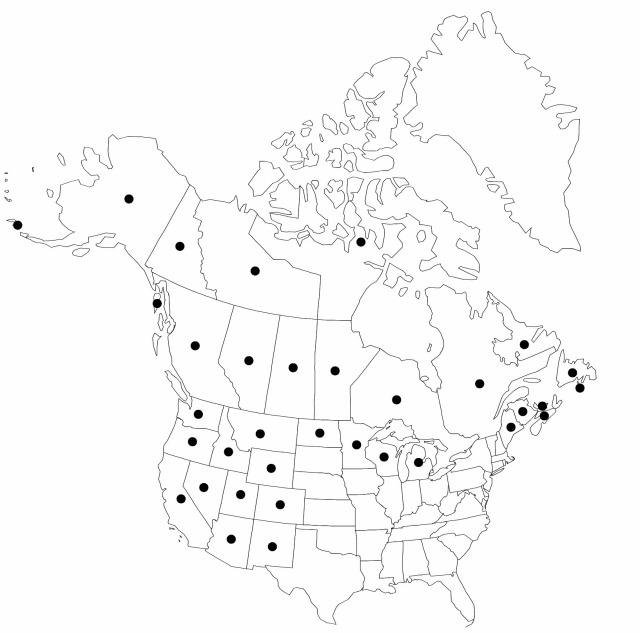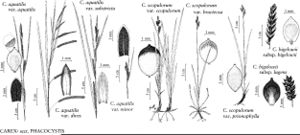Carex aquatilis var. aquatilis
Culms 20–120 cm, angles glabrous. Leaves: basal sheaths leafless, usually red-brown; blades amphistomic, 2.5–8 mm wide, papillose on both surfaces. Inflorescences: peduncle of proximal spike 1 cm or longer; proximal bract slightly longer than inflorescence, 2–8 mm wide. Spikes erect; proximal 2–7 spikes pistillate, 1–10 cm × 3–7 mm, base cuneate; terminal 2–4 spikes usually staminate. Pistillate scales red-brown to purple-brown with narrow pale midvein. Perigynia pale brown, ellipsoid or obovoid, 2–3.6 × 1.3–2.3 mm, apex rounded or obtuse; beak pale brown, thickened, not more than 0.2 mm. 2n = 72, 74–77, 79–80.
Phenology: Fruiting Jul–Aug.
Habitat: Marshes, bogs, wet meadows, shallow water along shores, usually in acidic substrates
Elevation: 0–3000 m
Distribution

St. Pierre and Miquelon, Alta., B.C., Man., N.B., Nfld. and Labr., N.W.T., N.S., Nunavut, Ont., P.E.I., Que., Sask., Yukon, Alaska, Ariz., Calif., Colo., Idaho, Maine, Mich., Minn., Mont., Nev., N.Mex., N.Dak., Oreg., Utah, Wash., Wis., Wyo., Eurasia.
Discussion
The circumboreal Carex aquatilis var. aquatilis is very common in wetlands of the northern and montane portions of North America. The plants are usually rhizomatous; in very wet or flooded sites they may form cespitose clumps.
Carex aquatilis var. aquatilis is distinguished from the sympatric Carex stricta by the sheaths not ladder-fibrillose, obovoid and veinless perigynia that are rounded at apex, glossy achenes, and amphistomic leaves. It is often confused with C. emoryi, and distinguished by perigynia that lack veins, concave sheath apex, glossy achenes, and amphistomic leaves. In western North America, it is often sympatric with C. scopulorum and may be distinguished by the pale brown perigynia, glossy achenes, and amphistomic leaves.
Carex aquatilis and C. scopulorum occasionally hybridize; hybrids have been named as C. ×sphacelata T. Holm and C. ×chionophila T. Holm. Carex aquatilis var. aquatilis overlaps and may intergrade with C. aquatilis var. dives along the Pacific Coast, with var. minor along the Arctic coast, and with var. substricta in the Great Lakes-New England region. Much of var. aquatilis in the southern part of its range has been called var. altior (L. H. Bailey) Rydberg. The type for var. altior is a specimen of C. emoryi.
Selected References
None.
